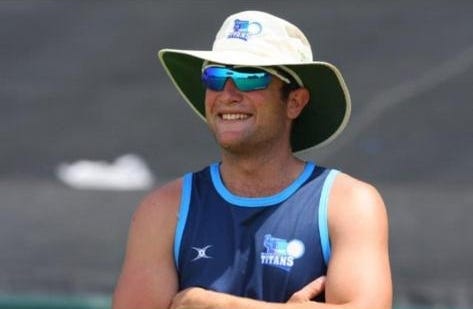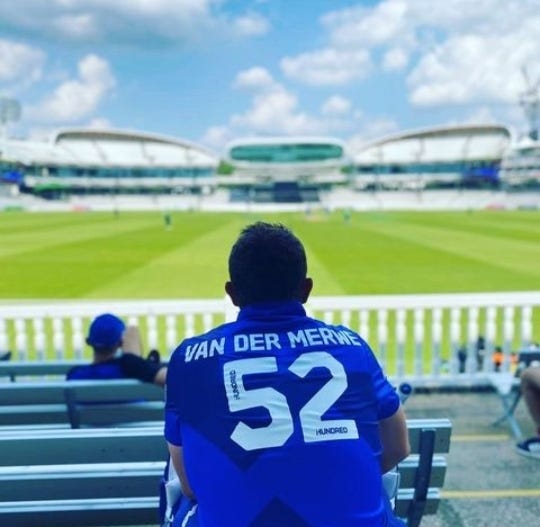In Greek mythology, the Titans were greater even than the gods. They ruled their universe with absolute power! Well that football field out there tonight, that's our universe. Let's rule it like Titans. - Coach Herman Boone (Remember The Titans).
If Ray Lewis played cricket, his name would be Roelof van der Merwe.
In October 2012, Ray Lewis tore his right triceps. The Baltimore Ravens linebacker did all he could, with the help of his doctors, and was back on the field after missing 10 matches. In February 2013, the night before the Super Bowl match, Lewis re-tore his triceps.
That night, the pain from the torn triceps was so bad he could not sleep. In the early hours of the morning, Lewis tied a shoestring around his arm and attached the other end to a sprinkler head in his hotel room, in an effort to get some pain relief and rest before the big game.
He then went on to record seven tackles in the Super Bowl the next day, four of which were solo tackles. Whenever he felt like giving up because of the pain, Lewis reminded himself, “It ain’t about you, it’s about the team.”
In October 2022, the world watched as Roelof van der Merwe staggered onto the pitch to join Max O’Dowd. He was in distressing physical pain.
described the scene perfectly, Roelof looked ‘like he'd just been dragged from a car crash and then forced to put on pads and a helmet and stagger out to the middle.’Roelof had suffered a facet joint injury two days earlier, in a match against Namibia. Facet joint injuries are often caused by excessive rotation (twisting) or extension (arching) motions of the facet joint. Roelof had been managing the pain with painkillers, but after he aggravated the condition in the match against Sri Lanka, it looked like only horse tranquillizers could provide relief.
O’Dowd gamely swung at every delivery he faced, while Roelof made his best impression of running between the wickets whenever he was required. Victory looked more improbable with every dot ball and single they took, but Roelof and O'Dowd refused to give up. They fought until the lights were turned out.
Roelof could have retired hurt at any point. He did not. His team had a shot at victory as long as he was out there. Roelof’s selfless effort was in vain, but his emotions did not curdle into disappointment. He was sad they had lost, but he was proud because he had given it everything, blood, sweat and tears.
For as long as Grant Morgan has known him, Roelof van der Merwe has always been that guy. Morgan has known Roelof for a long time. Roelof was fresh out of high school when they first met. Morgan divided his time between coaching Phobians (Pretoria High Old Boys Cricket Club) and playing for the Northerns.
“If I was asked to do an all-time 11 of players that I have coached, Roelof makes that team,” says Morgan.
During the 2004 season, Morgan watched as Roelof hand-held Phobians through a packed schedule. They played seven games in 10 days to lift the championship. After two days of celebration, Phobians to provide a touring New Zealand with a competitive warmup match. Roelof was the Energizer Bunny, he had boundless energy.
“Roelof showed incredible fighting spirit and durability throughout. He literally kept everyone going,” says Morgan. Morgan has a thousand and one stories of Roelof van der Merwe being an Energizer Bunny. He watched Roelof, a relatively unknown player, force his way into the RCB starting XI and play in the IPL final.
"That's Roelof. He is always up for a scrap," says Heino Kuhn. That is the same Roelof whom Chris van Noordwyk saw breaking through into the Titans’ first team and nicknamed pug because he was always up for a fight, and when there wasn’t one he picked one.
Roelof and Kuhn came up through the system together, from Under-11 cricket to Titans and then international cricket. One time, their team were headed into the last over but couldn't get the last wicket. Everyone looked resigned to a draw. Not Roelof.
He asked to swap wicketkeeping gloves with Kuhn so that he could bowl the final over. Long story short, Roelof took the last wicket, and that was the last match he played as the designated keeper. The double fist celebration became a trademark celebration, and that was also the beginning of Kuhn's career as a wicketkeeper.
When Joe Frazier sent Muhammad Ali to the canvas. Ali got up and fought on. After George Foreman blasted him with everything he had. Ali fought on. Ken Norton broke his jaw. Ali fought on. Roelof has this extraordinary fighter’s heart. He always gets up. Always. Things don't always turn out well in matches, but he always fights on.
“My dad's a very competitive person. So I assume he was a little competitive with me in whatever we did, whether it was golf, tennis or rolling a ball down the hallway to see you get closer to a toilet roll. I was also around him and his teammates, and they would have been competitive with me, they would have been competitive with each other and I probably saw that and it's just something I've adopted and taken forward in my more mature years,” says Roelof.
Roelof’s father played cricket for Eastern Country Districts. He was a fire-breathing seamer. For a while, it looked as if Roelof was going to follow in his footsteps. In his youth, Roelof ran in, as fast as he could, to deliver some mildly troubling left-arm pace. He never worked on that craft because he was intent on becoming a glove-wearing Jonty Rhodes behind the stumps.
This newsletter is completely reader-supported. If you’re willing and able, please consider supporting it in one of two ways, leaving a tip or becoming a Patreon. Thank you so much for your time and investment!
This is where they fought the battle of Gettysburg. Fifty thousand men died right here on this field, fighting the same fight that we are still fighting among ourselves today. This green field right here, painted red, bubblin' with the blood of young boys. Smoke and hot lead pouring right through their bodies. Listen to their souls, men. I killed my brother with malice in my heart. Hatred destroyed my family. You listen, and you take a lesson from the dead. If we don't come together right now on this hallowed ground, we too will be destroyed, just like they were. I don't care if you like each other or not, but you will respect each other. - Herman Boone.
When asked, Roelof points to Remember The Titans as his all-time favourite movie. He finds it exhilarating, touching and relatable. It goes beyond simply highlighting the struggles and triumphs of a basketball team, it offers a greater thematic context that reflects the human condition. Life, like team sports, is not about the individual, it is about the collective.
“When things are going up or down I always ask that question, am I giving energy or am I taking? I think that's my main thing. We all try to play our best and we all try to do well, but I think in the team space if I can give energy irrelevant of what the situation is or circumstances, I think that then I am in the right direction,” says Roelof.
Roelof doesn’t have the superstar ability of players like Rashid Khan or Jos Buttler. He rarely lifts teams to victory on his own. However, he has the ability to make the teams he is on better because he found a way of getting his fighting spirit to spread like a contagion within the teams that he is a part of.
“Roela is a teammate first and that is his biggest strength,” says Sarel Erwee. When Erwee joined the Sunrisers Eastern Cape squad after the Proteas’ tour to Australia, SEC had played and lost their opening matches. He first encountered Roelof in the nets where Roelof spent hours each day throwing balls and bowling to his teammates, and offering advice when he had something helpful to share about a batter’s technique.
During a 2007 tour to Sri Lanka Grant Morgan watched as Roelof provide his teammates with a support structure during a difficult series. Though he was young and not a star as most of his RCB teammates, Roelof played a similar role when he joined the IPL franchise in 2009. Over the years he has perfected the craft of building connections with teammates.
By the end of the first season of the SA20 tournament, the SEC dressing room had adopted Roelof’s double fist celebration whenever the Eastern Cape side took a wicket. Such was Roelof’s influence on his teammates. “His body language and energy just rubbed off on everyone,” says Erwee.
But, it wasn’t all serious faces and an unbroken focus on the game with Roelof. He was one of the first individuals who lightened the mood in sombre situations. Always had a joke up his sleeve. When the SEC media team was shooting short ‘know the player’ clips, they asked Roelof why his chosen jersey number was 52. His response was that it was closest to his age. He thought it was funny. And it was funny in a dad-joke way.
The truth behind number 52 is this: Roelof has a tendency to go on to YouTube and get lost deep in rabbit holes. He often spends hours watching videos. He has always done so. Years ago, he was asked to pick a shirt number by the Titans. He had just watched some stuff on Ray Lewis.
“I loved the way he the way he conducted himself,” says Roelof. “He was just an absolute machine. He had reached a mature age, he was still competing and fighting hard. And then there was the way he inspired people and the way that people followed him, it is something that I love. He wears 52 on his back and when I was asked to pick a number, I thought that would be fitting. So, I picked 52 that day. And it's been with me since.”
And so, maybe if Roelof van der Merwe played American football, he would be Ray Lewis, transforming pain into motivation and spending his career trying to make a positive impact.
If you found this interesting, please share it:
And you can support Stumped! by leaving a tip:
Thanks for reading. Until next time… - CS







